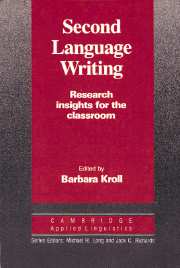Book contents
- Frontmatter
- Contents
- List of contributors
- Series editors' preface
- Preface
- Introduction
- I PHILOSOPHICAL UNDERPINNINGS OF SECOND LANGUAGE WRITING INSTRUCTION
- Chapter 1 Second language composition instruction: developments, issues, and directions in ESL
- Chapter 2 L1 composition theories: implications for developing theories of L2 composition
- Chapter 3 An overview of second language writing process research
- Chapter 4 Coaching from the margins: issues in written response
- Chapter 5 Second language writing: assessment issues
- Chapter 6 Reading–writing connections: toward a description for second language learners
- II CONSIDERATIONS FOR WRITING INSTRUCTION
- Index
Chapter 4 - Coaching from the margins: issues in written response
Published online by Cambridge University Press: 05 October 2012
- Frontmatter
- Contents
- List of contributors
- Series editors' preface
- Preface
- Introduction
- I PHILOSOPHICAL UNDERPINNINGS OF SECOND LANGUAGE WRITING INSTRUCTION
- Chapter 1 Second language composition instruction: developments, issues, and directions in ESL
- Chapter 2 L1 composition theories: implications for developing theories of L2 composition
- Chapter 3 An overview of second language writing process research
- Chapter 4 Coaching from the margins: issues in written response
- Chapter 5 Second language writing: assessment issues
- Chapter 6 Reading–writing connections: toward a description for second language learners
- II CONSIDERATIONS FOR WRITING INSTRUCTION
- Index
Summary
How best to respond to student writing is part of the broader question of how to create a context in which people learn to write better or more easily. To that end, teachers have tinkered with all aspects of the context: the number of assignments, the types of assignments, the nature of the relationship between teacher and student, and so on. This chapter addresses issues surrounding another aspect of the writing context, types of written responses to student writing. Although students often write responses to papers by their peers, the focus of this chapter is limited to responses written by teachers.
Murray (1968) tells the story of an advertising executive who received written reports from his staff. Since he sometimes felt that the reports were not well written, he developed a response strategy to improve his employees' writing. He took written reports home, and the next day returned the reports to their authors in his private office saying, “Is this the best you can do?” The authors sheepishly took the reports back, worked on them, and resubmitted them. The boss once again took them and the next day again asked, “Is this really the best you can do?” This continued until the authors finally said, “Yes, it is the best we can do!” And the boss answered, “Good, then I'll read it.”
- Type
- Chapter
- Information
- Second Language Writing (Cambridge Applied Linguistics)Research Insights for the Classroom, pp. 57 - 68Publisher: Cambridge University PressPrint publication year: 1990
- 75
- Cited by



